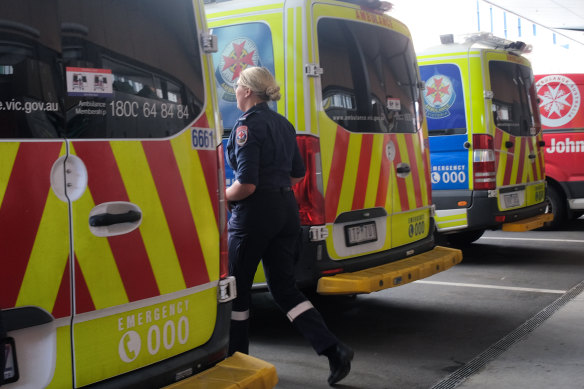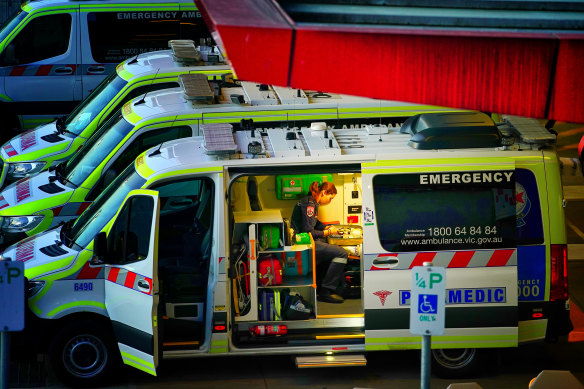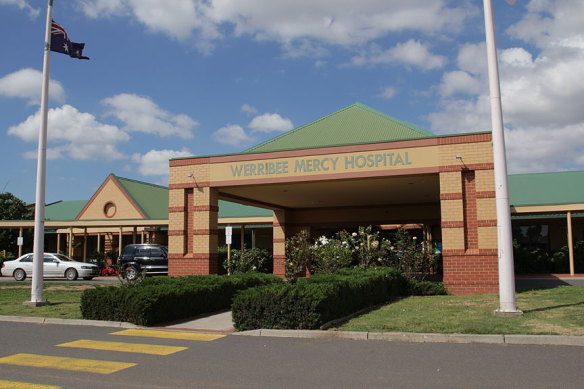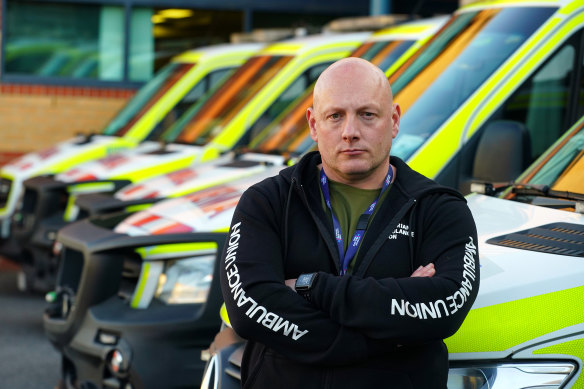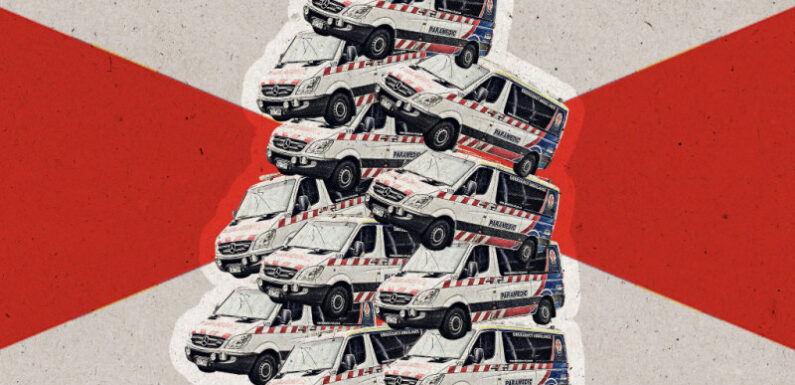
Save articles for later
Add articles to your saved list and come back to them any time.
Key points
- Ambulance and patient transport crews have spent more than 523,000 hours waiting at emergency departments since 2018.
- This represents more than a century of paramedic time lost to ramping, or 60 years of one ambulance being ramped and about $105 million in paramedic wages.
- Paramedics in Victoria are experiencing the worst delays at Sunshine and Austin hospitals. Ramping is also pronounced at Box Hill, Monash, Maroondah, Royal Melbourne, Northern and Frankston hospitals.
- Ambulance ramping has worsened as Australians find it harder to access GP or specialist appointments and arrive at hospitals sicker than before.
- As ramping has increased, ambulance response times have plunged well below the statewide benchmark.
Paramedics have spent a cumulative 120 years waiting for sick or injured patients to be admitted to overcrowded hospitals in the past five years, according to new data exposing the severity of the state’s ambulance ramping crisis.
Internal Ambulance Victoria records obtained by this masthead through freedom of information laws show that ambulance and patient transport crews spent more than 523,000 hours waiting at emergency departments since 2018, delaying their return to the road to help other Victorians.
A paramedic at Sunshine Hospital last week. There were about 10 patients waiting inside with paramedics.Credit: Luis Enrique Ascio
As each ambulance is generally staffed by two paramedics, this represents more than a century of paramedic time lost to ramping, or 60 years of one ambulance being ramped and, according to a senior emergency services source, about $105 million in paramedic wages.
This week, this masthead toured ambulance waiting areas at hospitals in Melbourne’s west, north and east, speaking to about a dozen paramedics, who were not authorised to comment publicly.
They said Victorians with potentially life-threatening conditions were among those stuck in crowded hospital corridors waiting to be admitted, while others had wet themselves on ambulance stretchers due to lengthy delays.
“This is honestly the worst I have seen,” said one paramedic with more than 20 years of experience.
“We didn’t sign up to play babysitter for the hospitals, while sick people wait.”
Ramping, often defined as when paramedics are delayed at hospitals for more than 40 minutes, has plagued Australian hospitals for years, but the situation has deteriorated sharply since the pandemic.
Ambulance Victoria’s executive director of clinical operations, Anthony Carlyon, said he heard from frustrated paramedics every day who were concerned about ramping.
“It is impacting our ability to care for people in the community, there’s no doubt about that.”
Paramedics in Victoria are experiencing the worst delays at Sunshine and Austin hospitals, where crews were ramped for more than 13,500 hours in the past financial year. Ramping is also pronounced at Box Hill, Monash, Maroondah, Royal Melbourne, Northern and Frankston hospitals, which all experienced annual ramping above 11,000 hours.
Outside Melbourne, extreme levels of ambulance congestion have been recorded at Ballarat Base Hospital, where crews were ramped for 4477 hours, as well as Latrobe, Bairnsdale and Wonthaggi hospitals, where ambulances were ramped between 3120 and 1125 hours annually.
The key cause of ambulance ramping is a lack of hospital beds, which leads to clogged emergency departments because there is nowhere to move patients.
The phenomenon has worsened as Australians find it harder to access GP or specialist appointments and arrive at hospitals sicker than before.
A paramedic at work inside an ambulance parked at Box Hill Hospital, one of the worst hospitals in the state for ambulance ramping.Credit: Luis Enrique Ascui
Hundreds of patients are also stuck in hospital wards waiting to access disability support or an aged care bed, sectors overseen by the federal government.
With no easy fix for the worsening problem, emergency doctors and the groups representing paramedics say it’s time to redesign the health system so that emergency departments are no longer so heavily relied on for medical care.
“It’s a wicked problem,” said Dr Andy Tagg, deputy chair of the Australasian College for Emergency Medicine’s Victorian faculty.
Tagg said prolonged waiting times were leading to increasing aggression towards health workers.
“Hospitals run at 100 per cent capacity,” he said. “There’s no flex in the system.”
Paramedics say their two-person crews are sometimes spending entire shifts waiting at hospitals with a single patient who has relatively minor complaints.
“We’re producing risk out in the community because we are stuck here,” said one paramedic whose ambulance was ramped alongside 10 others at Box Hill Hospital last week.
On the other side of town at Sunshine Hospital, where there were about 20 paramedics waiting, another experienced paramedic said he was preparing to be stuck at the emergency department for much of his shift.
“We could be here for four hours,” he said. “Some days, I can do two jobs. [I’ll] bring the first patient in, spend four hours here, go do another job and spend another four hours. Then my day is done.”
In Victoria, the time paramedics lost to ramping has jumped almost four-fold over the past five years, to more than 165,000 hours last financial year. The data also includes delayed non-emergency transfers.
As ramping has increased, ambulance response times have plunged well below the statewide benchmark. In the last quarter of this year, ambulances were only able to reach 61.7 per cent of code-one cases within 15 minutes, well short of the target of 85 per cent.
Meanwhile, patients waiting in ambulances or corridors with paramedics have dangerously deteriorated without full access to hospital tests and treatment.
A young mother with a suspected postpartum haemorrhage died in 2020 after her ambulance was ramped at the Werribee Mercy Hospital. Credit: Supplied
Last year, a man brought to Bairnsdale Regional Health Service by ambulance died of a cardiac arrest after waiting with paramedics for more than three hours. In 2020, a young mother with a suspected postpartum haemorrhage died after her ambulance was ramped at the Werribee Mercy Hospital.
System insiders say the cases of patient harm that make their way into the media are just the tip of the iceberg.
Carlyon, from Ambulance Victoria, confirmed that some cases where “transfer delays” may have impacted patient outcomes had been reported to Victoria’s hospital watchdog, Safer Care Victoria.
He is hopeful that ramping rates will be reduced with the help of several new initiatives that try to reduce unnecessary ambulance dispatches or redirect patients to another service, including the Victorian Virtual Emergency Department, where patients can be seen via video call and avoid a hospital visit.
Victorian Ambulance Union secretary Danny Hill says some paramedics worry they are losing on-road expertise as they are spending so much time ramped at hospitals.Credit: Luis Enrique Ascui
“We’ve transferred more than 40,000 patients to that service … since October [20]21.”
Victorian Ambulance Union secretary Danny Hill said hospitals were relying on paramedics to look after patients in their corridors and a new approach was needed to avoid handover delays.
“If hospitals took responsibility for patients as soon as they arrived, there would be many more ambulances on the street today,” he said.
The issue of “bed block” was raised at a meeting of state and federal health ministers on Friday. A Victorian government spokeswoman said access to GPs, which are funded by the federal government, and bed availability were at the heart of the issue.
She said patients who had struggled to access GPs were arriving at hospital sicker and staying for longer.
“To give patients the timely care they deserve, the whole system has to work together – not just paramedics and emergency departments, but primary care, aged care and the NDIS [National Disability Insurance Scheme],” she said.
She pointed out that about 80 per cent of patients were transferred to hospital within one hour.
The state government’s virtual emergency department, expanded secondary triage, recruitment and training of 6200 healthcare workers, and 27 priority primary care centres were relieving pressure on emergency departments and improving transfer times, the spokeswoman said.
She said 300 Victorians with a disability were medically fit to go home but waiting for their NDIS care plans to be approved.
The Morning Edition newsletter is our guide to the day’s most important and interesting stories, analysis and insights. Sign up here.
Most Viewed in National
From our partners
Source: Read Full Article
